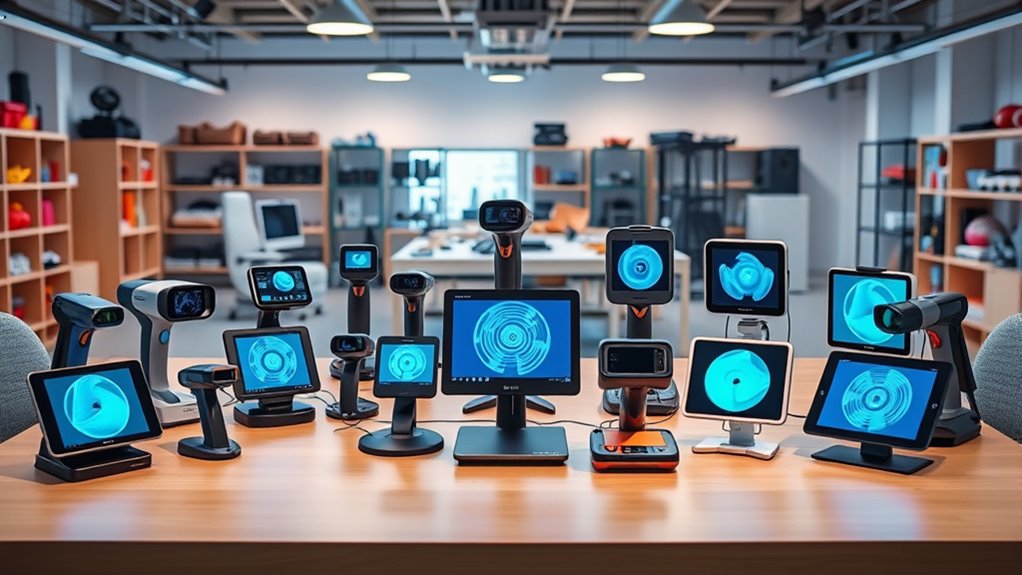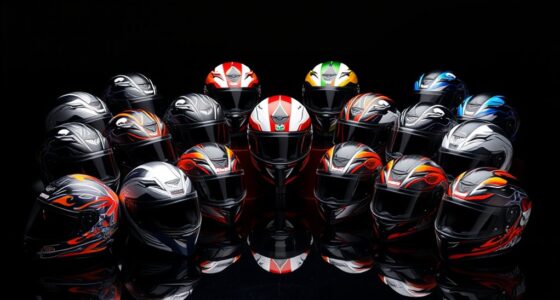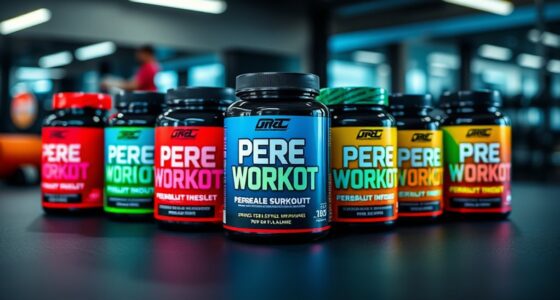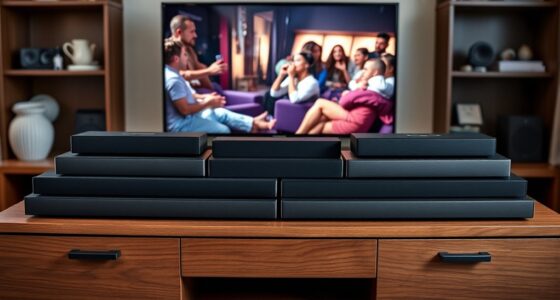If you’re looking for the best 3D scanners for 2025 that combine accuracy, user-friendliness, and affordability, I’ve got you covered. Models like the Revopoint POP3 Plus, MIRACO Plus, and Creality CR-Scan Ferret Pro stand out for their precision and portability. These devices suit both hobbyists and professionals, capturing detailed textures in various environments. Keep exploring to find out which options meet your needs and how they can elevate your 3D printing projects.
Key Takeaways
- High-precision handheld scanners like Revopoint POP3 Plus and MIRACO Pro offer accuracy within 20 microns for detailed 3D printing projects.
- Portable, user-friendly designs with wireless connectivity (Wi-Fi 6, USB-C) ensure easy, flexible scanning in various environments.
- Capable of capturing full-color textures on complex surfaces, ideal for realistic 3D printing and digital art applications.
- Compatibility across Windows, macOS, iOS, and Android, with simple software interfaces suitable for both hobbyists and professionals.
- Many models support large object sizes up to 560*820mm, making high-accuracy, affordable 3D scanning accessible for diverse needs in 2025.
Revopoint MetroX 3D Scanner for 3D Printing
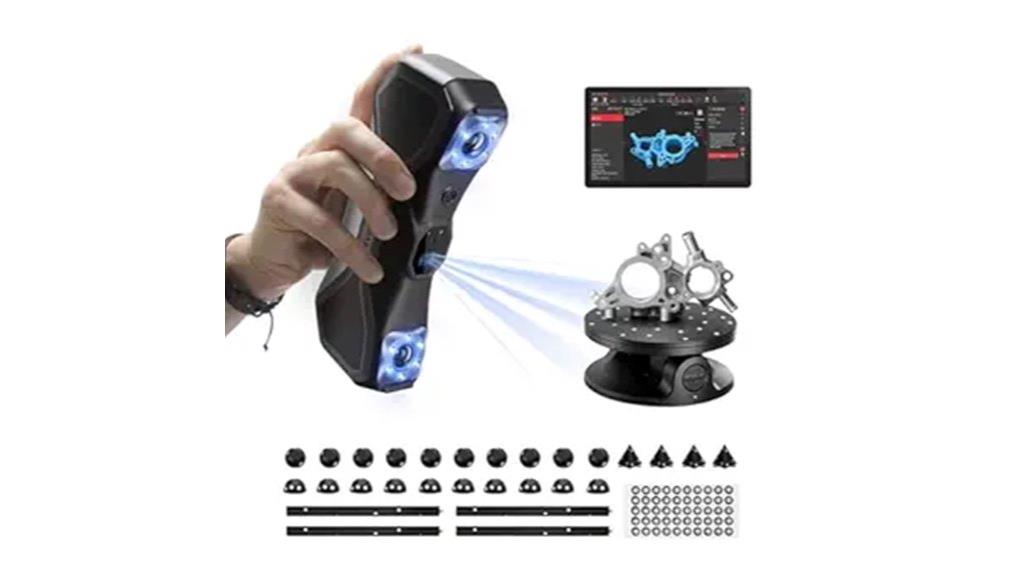
If you’re seeking a high-precision 3D scanner that can handle industrial and creative projects alike, the Revopoint MetroX is an excellent choice. It offers industrial-grade blue laser scanning with up to 0.02 mm accuracy and 0.01 mm precision, supporting multiple modes like Cross Lines and Auto Turntable for fast, detailed scans. With GPU-accelerated lasers at 60 fps, it handles dark or shiny surfaces without spray. Equipped with an RGB camera, it captures color textures easily. Its balance of accuracy, portability, and user-friendly software makes it ideal for quality control, high-precision measurement, and creative modeling.
Best For: professionals and enthusiasts needing high-precision industrial and creative 3D scans with detailed color textures and versatile scanning modes.
Pros:
- Extremely high accuracy of up to 0.02 mm and precision of 0.01 mm, suitable for industrial quality control and detailed modeling
- Supports multiple scanning modes including Auto Turntable and Cross Lines for flexible, rapid, and automated scanning workflows
- Equipped with GPU-accelerated blue laser lines and an RGB camera, allowing effective scanning of dark or shiny surfaces without the need for spray
Cons:
- Less portable due to the requirement of a laptop, power source, and cabling, limiting on-the-go use
- Post-processing and calibration skills are necessary to convert raw data into usable 3D models, which may involve a learning curve
- Surface preparation with sprays like AESUB AZUL is often needed for shiny or reflective objects, adding extra steps and waiting time
Creality CR-Scan Ferret Pro 3D Scanner
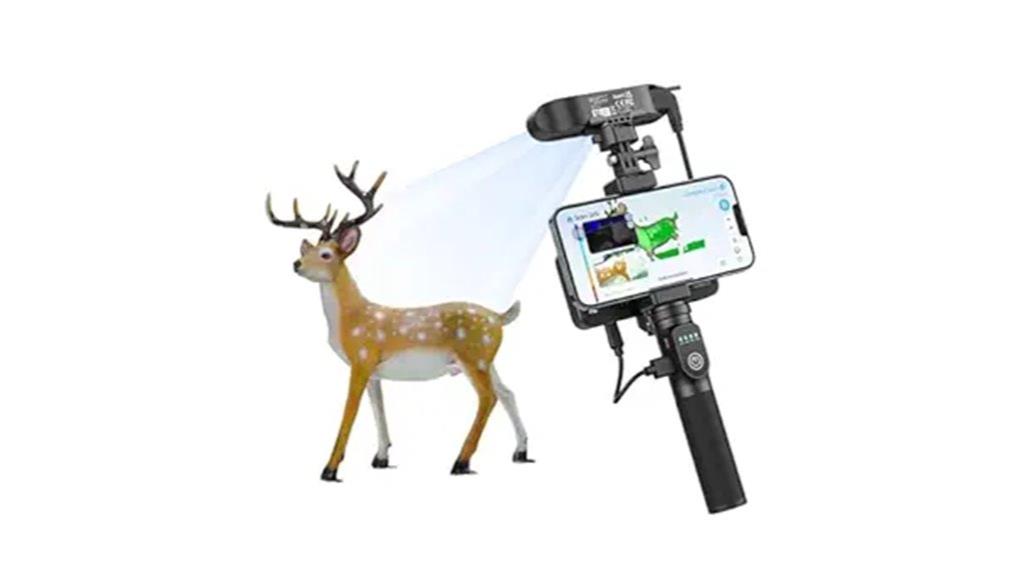
The Creality CR-Scan Ferret Pro stands out for its high accuracy and fast scanning capabilities, making it ideal for professionals and serious hobbyists who need detailed, textured 3D models. It offers up to 0.1mm accuracy and can quickly capture medium to large objects like cars and tires, even on black or metallic surfaces without spray. The device supports full-color, textured scans with a high-resolution camera, compatible with popular software like Blender and Fusion 360. With WiFi6 for speedy data transfer and handheld stability features, it’s versatile, but users should note that software stability varies, especially on Mac. Overall, it’s a powerful tool if paired with a high-performance PC.
Best For: professionals and serious hobbyists who require high-precision, textured 3D scans of medium to large objects, especially on challenging surfaces like black or metallic finishes.
Pros:
- Provides high accuracy up to 0.1mm, capturing detailed textures and dimensions.
- Supports rapid, full-color 3D scanning suitable for complex surfaces and outdoor environments.
- Compatible with multiple professional software platforms and offers versatile hardware features for handheld scanning.
Cons:
- Software stability issues, particularly on macOS and with app crashes, can hinder workflow.
- Requires a high-performance PC for optimal operation, which may increase overall cost.
- Limited recent updates and inconsistent customer support experiences may affect usability over time.
Revopoint MIRACO Plus 3D Scanner for 3D Printing

For those seeking a portable yet highly precise 3D scanner, the Revopoint MIRACO Plus stands out as an excellent choice in 2025. Weighing only 750g, it’s easy to carry and operate, featuring a 6-inch 2K AMOLED flip screen for clear viewing. Its dual scanning modes—single-shot for detail and continuous for speed—cover a wide range of objects, while the quad-depth camera and infrared zoom improve surface detail. With an accuracy of 0.02 mm + 0.05 mm x L, it’s perfect for 3D printing, reverse engineering, and product design. Plus, its fast data transfer, high-resolution RGB camera, and user-friendly software make it a versatile, reliable tool.
Best For: professionals and hobbyists seeking a portable, high-precision 3D scanner for detailed 3D printing, reverse engineering, and product design projects.
Pros:
- Lightweight and portable at only 750g with a user-friendly 6-inch 2K AMOLED flip screen.
- Versatile scanning modes (single-shot and continuous) with high accuracy of 0.02 mm + 0.05 mm x L, suitable for various object sizes.
- Supports fast data transfer, high-resolution RGB imaging, and compatible file formats for seamless integration with CAD and 3D software.
Cons:
- Slower scanning speeds for larger or reflective/dark objects, which may require additional preparation.
- Battery life may drain quickly when using onboard lighting or during extended scanning sessions.
- Challenges with shiny, dark, or highly reflective surfaces that can affect scan quality.
Revopoint Inspire 3D Scanner for 3D Printing
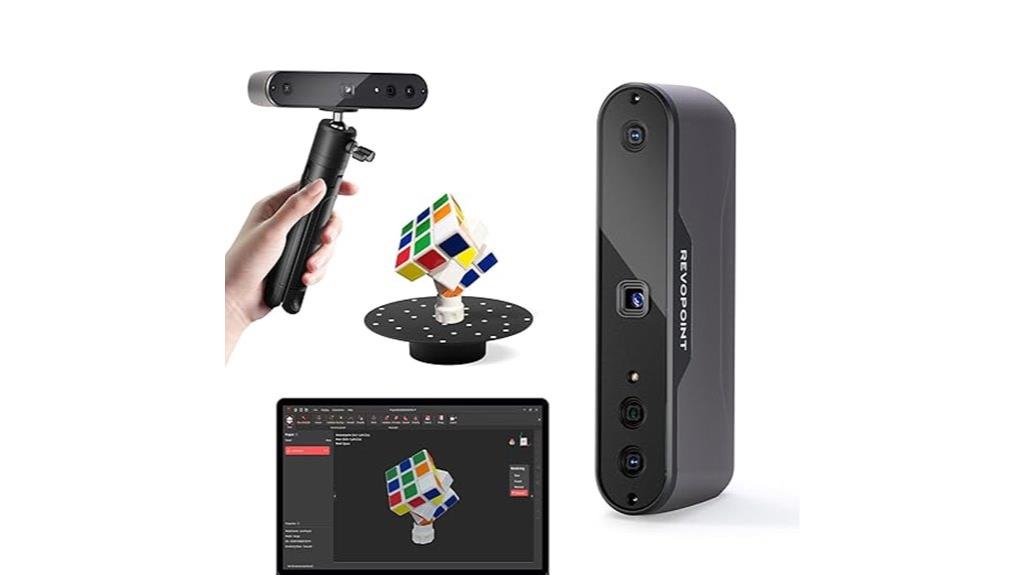
The Revopoint Inspire 3D Scanner stands out as an excellent choice for hobbyists and professionals seeking high-precision, portable scanning for 3D printing. With 0.2 mm accuracy and a capture area of 308mm x 225mm at 500mm, it produces detailed, full-color models ideal for various applications like digital art, car customization, and historical preservation. Weighing just 140 grams, it’s easy to use on the go via smartphone with Wi-Fi 6 or through USB Type-C for object scans on a mini turntable. Its intuitive software supports multiple formats, making it accessible for beginners while satisfying advanced users. Overall, Inspire combines precision, portability, and user-friendly features effortlessly.
Best For: hobbyists and professionals seeking high-precision, portable 3D scanning solutions for applications like 3D printing, digital art, and restoration projects.
Pros:
- High accuracy of 0.2 mm with vibrant full-color texture mapping for realistic models
- Lightweight and portable design weighing only 140 grams, ideal for on-the-go scanning
- Supports multiple connectivity options including Wi-Fi 6 and USB Type-C, compatible with various devices and software
Cons:
- May have difficulty scanning non-white, reflective, or complex objects effectively
- Software can have limitations like dark mode issues and occasional glitches
- Additional accessories such as larger turntables or mats may be needed for enhanced stability and usability
Creality 3D Scanner CR-Scan Ferret Pro

If you’re seeking a portable 3D scanner that delivers high-precision, full-color results without breaking the bank, the Creality CR-Scan Ferret Pro stands out as an excellent choice. Weighing just 105 grams, it’s lightweight and supports wireless scanning via WiFi6, compatible with iOS, Android, Windows, and macOS. It offers 0.1mm accuracy, anti-shake tracking, and performs well in various lighting conditions, including sunlight. The device comes with useful accessories like a tripod, power bank, and carrying case. While some users face software hiccups and tracking issues, proper setup and additional tools like turntables can greatly enhance results, making it ideal for both beginners and professionals.
Best For: hobbyists, educators, and small-scale professionals seeking an affordable, portable, high-precision 3D scanner for small to medium objects.
Pros:
- Lightweight (105 grams) and highly portable for on-the-go scanning
- Supports wireless scanning with WiFi6 and multiple device compatibility (iOS, Android, Windows, macOS)
- Capable of detailed, full-color scans with 0.1mm accuracy and effective in various lighting conditions
Cons:
- Software can be buggy, slow, and incompatible with some systems, especially Mac
- Tracking loss and processing issues may require additional setup and patience
- Limited advanced features compared to high-end scanners, and some security concerns with unsecured WiFi network
Revopoint POP3 Plus 3D Scanner for 3D Printing
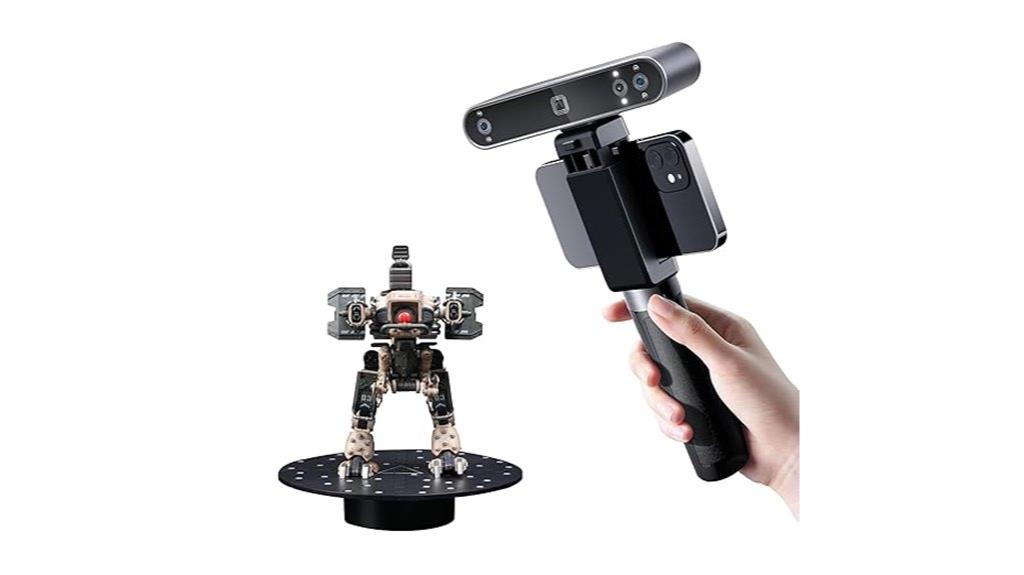
When precision matters most, the Revopoint POP3 Plus stands out as an ideal choice for 3D printing, thanks to its refined accuracy within 20 microns. This handheld scanner captures detailed, high-quality models of medium-sized objects, supported by optical zoom and a full-color HD RGB camera. Weighing only 190 grams, it’s portable and easy to operate on multiple platforms via Wi-Fi 6 or USB-C. Its fast scanning speed of 18 fps, stabilized by a 9-axis IMU, ensures smooth results. Perfect for product design, animation, or preservation, the POP3 Plus balances affordability with professional-level accuracy.
Best For: hobbyists and professionals seeking high-precision 3D scanning of medium-sized objects for printing, modeling, and preservation projects.
Pros:
- Very high accuracy within 20 microns, ideal for detailed 3D printing and modeling.
- Lightweight and portable at only 190 grams, suitable for on-the-go use across multiple platforms.
- Fast scanning speed of 18 fps with stabilization, ensuring efficient and smooth captures.
Cons:
- Struggles with shiny, black, or reflective surfaces without additional coatings or markers.
- Limited to medium-sized objects; large object scanning is not practical due to the scan area.
- Some users have experienced hardware issues like faulty cables or turntables, requiring additional support or replacements.
Creality CR Scan Ferret Pro 3D Scanner
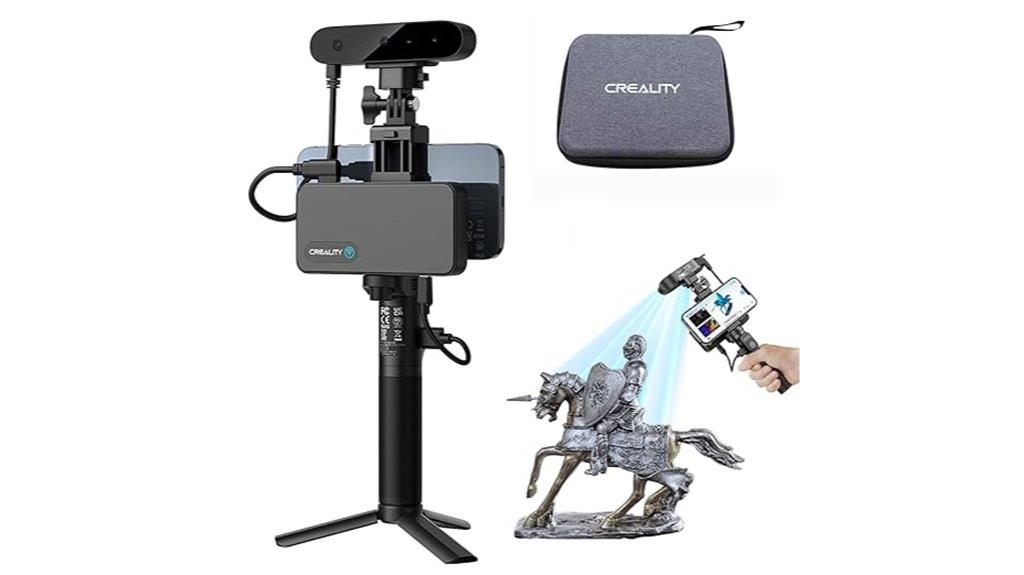
For professionals and hobbyists seeking high-precision, full-color 3D scans on the go, the Creality CR Scan Ferret Pro stands out as an excellent choice. It offers 0.1mm accuracy with vibrant, 24-bit color capture, thanks to its high-resolution camera and advanced face mapping algorithms. Its anti-shake technology guarantees steady scans even with hand tremors, and it can handle dark and metallic surfaces without spraying, making it versatile for various materials. Weighing just 105 grams, its compact design allows outdoor and indoor use under bright sunlight. With WiFi 6 and multiple device compatibility, it’s user-friendly and perfect for creative, engineering, and design projects.
Best For: professionals and hobbyists seeking portable, high-precision, full-color 3D scanning for creative, engineering, or design projects both indoors and outdoors.
Pros:
- Achieves 0.1mm high-precision accuracy with vibrant 24-bit full-color capture
- Anti-shake technology ensures steady scans even with hand tremors and handles dark or metallic surfaces without spraying
- Lightweight (105 grams) and portable, suitable for outdoor use under bright sunlight with wireless connectivity options
Cons:
- May require familiarity with setup guides and tutorials for optimal use
- Higher cost compared to simpler or less advanced 3D scanners
- Limited scan size may not accommodate very large objects in a single pass
3D Scanner Raptor Pro and Scan Bridge Wireless 3D Scanner for Printing
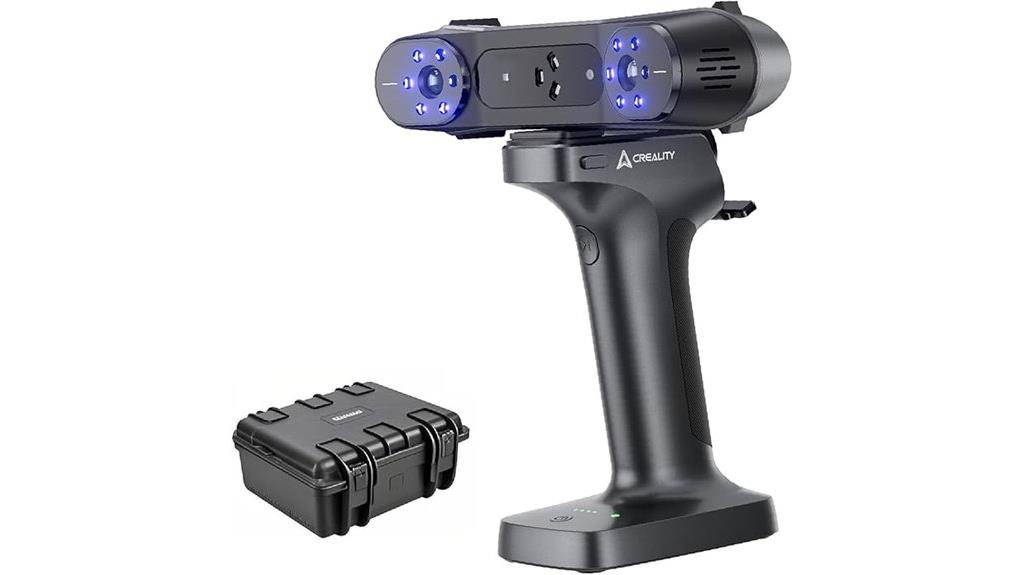
The 3D Scanner Raptor Pro combined with Scan Bridge Wireless offers a standout solution for professionals demanding high-precision scans for 3D printing. It features 22+7 blue laser lines, capturing up to 660,000 points per second with an accuracy of 0.02mm. Its portability, thanks to a handle, allows use with smartphones or laptops, making it versatile for detailed modeling and reverse engineering. Wireless connectivity enhances convenience, though it can be temperamental at longer distances. Despite some software stability issues, the Raptor Pro delivers sharp, realistic textures and precise measurements, making it a reliable choice for those seeking professional-grade 3D scans.
Best For: professionals and enthusiasts needing high-precision, portable 3D scanning for printing, reverse engineering, and detailed modeling.
Pros:
- High accuracy of 0.02mm and fast capture rate of 660,000 points per second for detailed scans
- Portable design with a handle allows easy use with smartphones or laptops in various environments
- Supports full-color 3D scanning for realistic textures and detailed modeling
Cons:
- Wireless connectivity can be unstable, especially beyond 8 feet or with certain devices
- Software stability issues, with some versions being buggy and prone to crashes or timeouts
- Limited tutorials and user guidance, making it less beginner-friendly despite its ease of setup
Einstar Handheld 3D Scanner Pro
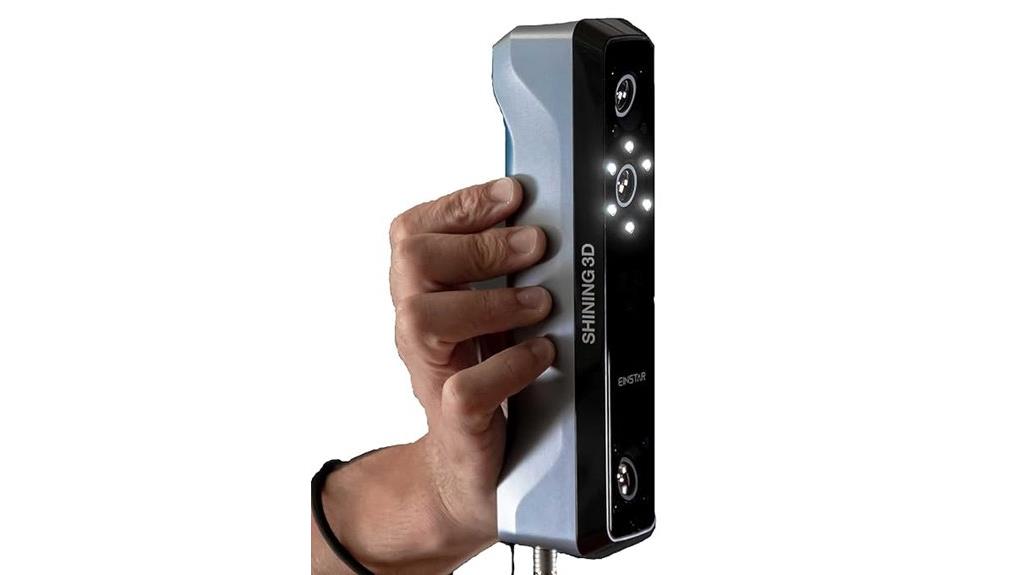
If you’re looking for a portable 3D scanner that combines affordability with high accuracy, the Einstar Handheld 3D Scanner Pro is an excellent choice. Weighing under 1kg, it’s designed for easy, on-the-go scanning, with an ergonomic handheld form that works in various environments without markers or complicated setups. Its infrared VCSEL structured light technology and RGB camera produce detailed, full-color, photorealistic scans at up to 0.1mm resolution. Compatibility with major file formats and operating systems makes it versatile for professionals and hobbyists. While it offers impressive performance for its price, achieving perfect scans may require practice, especially with complex surfaces.
Best For: hobbyists, small businesses, and professionals seeking portable, high-accuracy 3D scanning without the need for expensive equipment.
Pros:
- Compact and lightweight design under 1kg for easy portability and on-the-go use
- High-resolution scans up to 0.1mm with full-color, photorealistic detail thanks to infrared VCSEL and RGB camera technology
- Compatible with major file formats and operating systems, supporting a wide range of applications from art to reverse engineering
Cons:
- Achieving optimal scans requires practice and may involve a learning curve, especially with complex surfaces
- Some users report difficulties with calibration and failed scans despite firmware updates and adjustments
- Not always suitable for simple or straightforward objects without experience, as success heavily depends on user skill
Shining 3D Einstar Handheld 3D Scanner
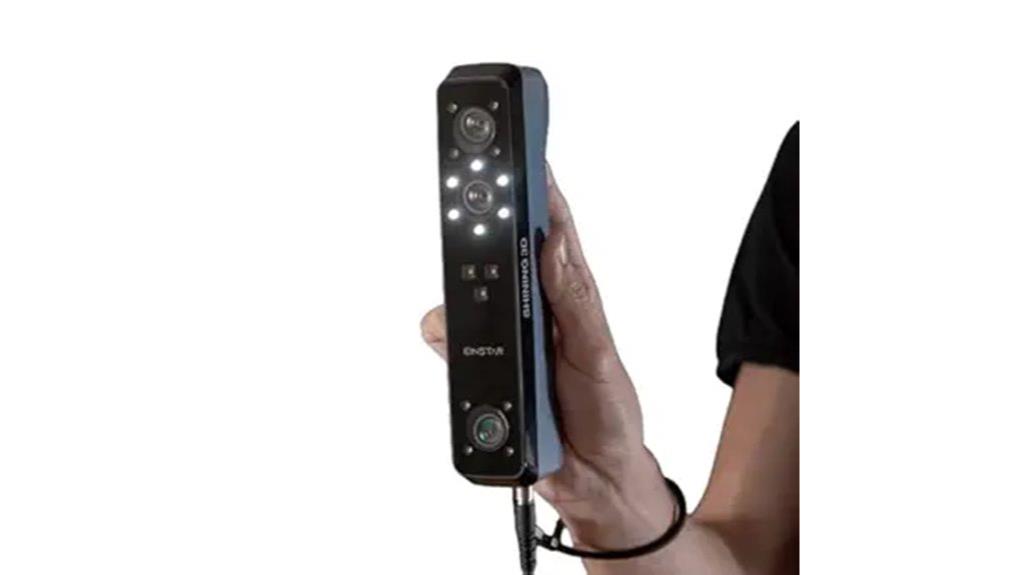
The Shining 3D Einstar Handheld 3D Scanner stands out as an excellent choice for hobbyists and small businesses seeking professional-quality results without breaking the bank. Its durable build and advanced hardware—infrared VCSEL projectors, stereo depth cameras, and an RGB camera—allow for stable indoor and outdoor scanning, even of hair and body. With a maximum speed of 14 FPS and high-density point cloud data, it captures detailed textures and complex surfaces, including shiny and dark objects. The intuitive software offers automatic alignment, detail enhancement, and exports compatible with most 3D printing workflows. While some UI quirks exist, the Einstar delivers impressive accuracy at a fraction of high-end scanner prices.
Best For: hobbyists and small businesses seeking affordable, professional-grade 3D scanning of complex objects indoors and outdoors with high detail and texture fidelity.
Pros:
- Durable build with advanced hardware including infrared VCSEL projectors and RGB camera for stable outdoor and indoor scans
- Captures high-density point cloud data with detailed textures, suitable for complex and shiny surfaces
- User-friendly software with automatic alignment, detail enhancement, and broad export options
Cons:
- Software can crash or experience issues, especially on certain Mac systems or with outdated UI
- Requires additional accessories like spray powders or tracking dots for optimal results on difficult surfaces
- Connection compatibility issues with some computers and the need for powerful CPU and RAM for optimal performance
Revopoint MIRACO Pro Wireless 3D Scanner
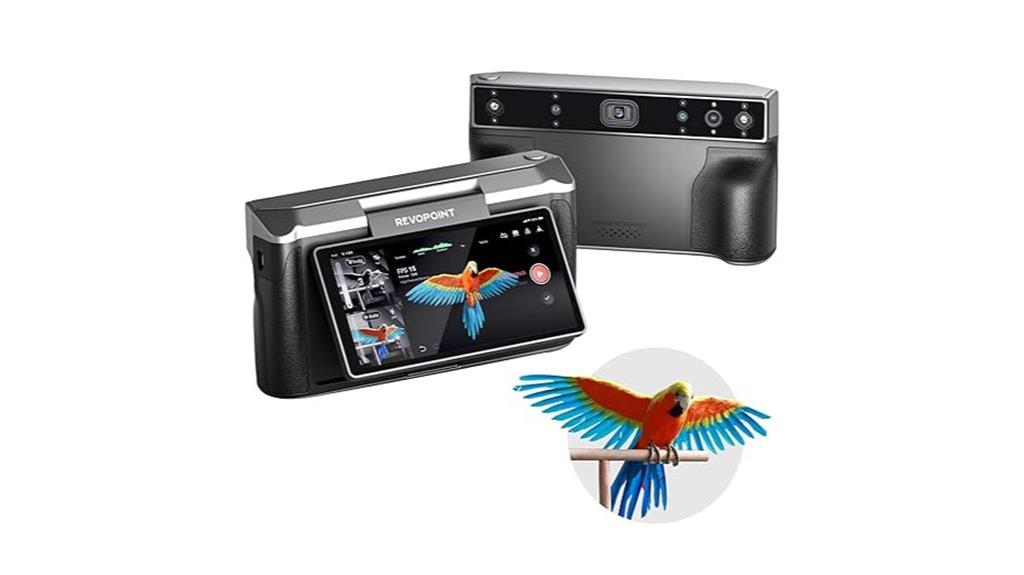
For those seeking a portable, high-precision 3D scanner, the Revopoint MIRACO Pro Wireless stands out with its single-frame accuracy of up to 0.02mm. Weighing just 750 grams, it’s a compact, handheld device that requires no cables or computer, making it perfect for on-the-go scanning. Its quad-depth camera system adapts to different object sizes, from small parts to large machinery, with near-mode for fine details and far-mode for larger surfaces. The 48MP RGB camera and Flash LED produce full-color, photorealistic models. Powered by an 8-core processor and supporting Wi-Fi 6, it’s a versatile, user-friendly tool for precise 3D printing projects.
Best For: professionals and hobbyists seeking a portable, high-precision 3D scanner for detailed object capture and on-the-go scanning projects.
Pros:
- Lightweight and compact design (750g) for easy one-handed operation and portability.
- High-precision single-frame accuracy of up to 0.02mm for detailed 3D models.
- Full-color, photorealistic 3D output with 48MP RGB camera and Flash LED.
Cons:
- Limited battery life of 2 hours may require frequent recharging during extended sessions.
- The high-end hardware and features may come with a higher price point.
- Requires Wi-Fi 6 or Type-C USB connection, which may not be available in all environments.
Creality CR Scan Ferret Pro 3D Scanner for 3D Printing
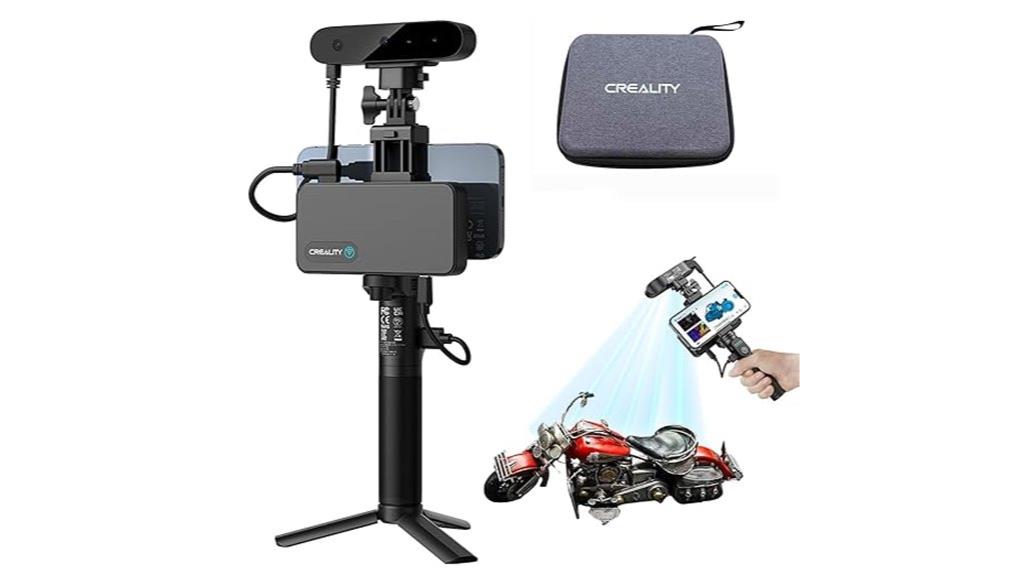
The Creality CR Scan Ferret Pro stands out as an ideal choice for professionals and hobbyists seeking a portable, high-precision 3D scanner. Weighing only 105 grams, it’s incredibly easy to carry everywhere, making outdoor or on-the-go scanning simple. Its accuracy reaches up to 0.1mm, capturing detailed models from various surfaces, including dark and metallic objects, without extra prep. The scanner supports wireless connectivity via WiFi 6 or USB, compatible with PC, Mac, iOS, and Android devices. Its real-time anti-shake tracking guarantees stable, precise results even during movement, making it versatile for art, design, and industrial applications.
Best For: professionals and hobbyists seeking a portable, high-accuracy 3D scanner capable of capturing detailed models in various environments, including outdoor and industrial settings.
Pros:
- Lightweight and portable at only 105g for easy on-the-go scanning
- High accuracy up to 0.1mm for detailed 3D models
- Supports wireless connectivity via WiFi 6 and USB across multiple devices and platforms
Cons:
- USB connection not supported on iPhone devices
- May require some initial setup or tutorials for optimal use
- Limited to 2MP RGB camera, which might be less suitable for extremely high-fidelity color projects
Creality 3D Scanner CR-Scan Ferret for 3D Printing
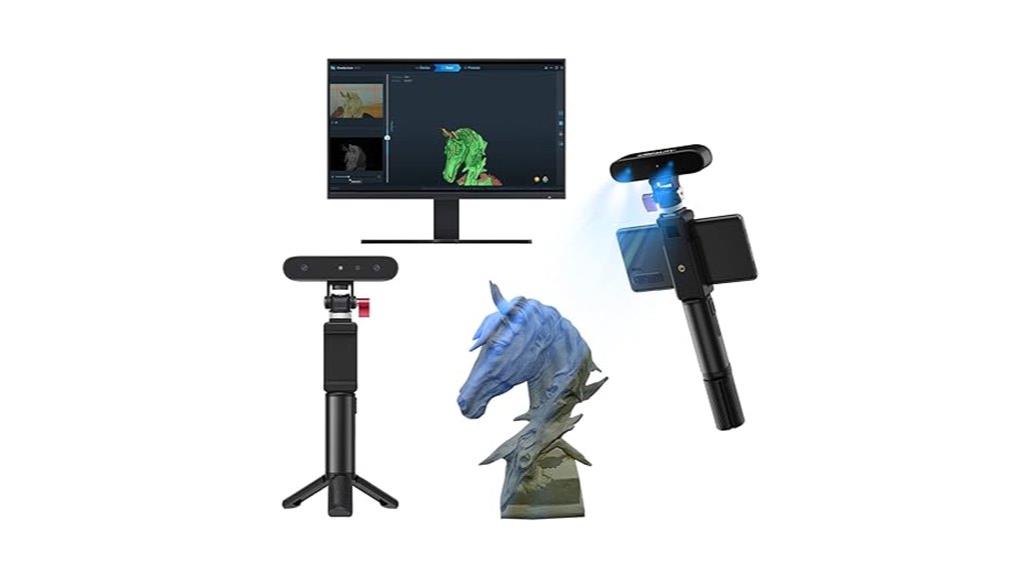
If you’re seeking a handheld 3D scanner capable of capturing detailed, full-color models, the Creality CR-Scan Ferret stands out as a solid choice. It offers dual scanning modes—wide-range and high-accuracy—handling objects up to 560*820mm with 0.1mm precision and vibrant color textures. Its ASIC chipset processes images at 60 fps, making scans faster and smoother. Compatible with Android phones, Windows, and macOS, it’s flexible for on-the-go use, powered via USB or power banks. While setup can be tricky and software needs polishing, its high accuracy and color detail make it suitable for precise 3D printing projects.
Best For: hobbyists and professionals seeking detailed, full-color 3D scans of small to medium objects for precise 3D printing projects.
Pros:
- High-precision scanning with 0.1mm accuracy and vibrant full-color textures
- Dual scanning modes suitable for a wide range of object sizes up to 560*820mm
- Fast image processing at 60 fps with an ASIC chipset for smoother, quicker scans
Cons:
- Setup and calibration can be complex and time-consuming, especially for beginners
- Outdated ergonomics with cumbersome cables and no built-in battery reduce portability
- Software usability issues, including confusing prompts and occasional crashes, may hinder user experience
Revopoint Range 2 3D Scanner for 3D Printing
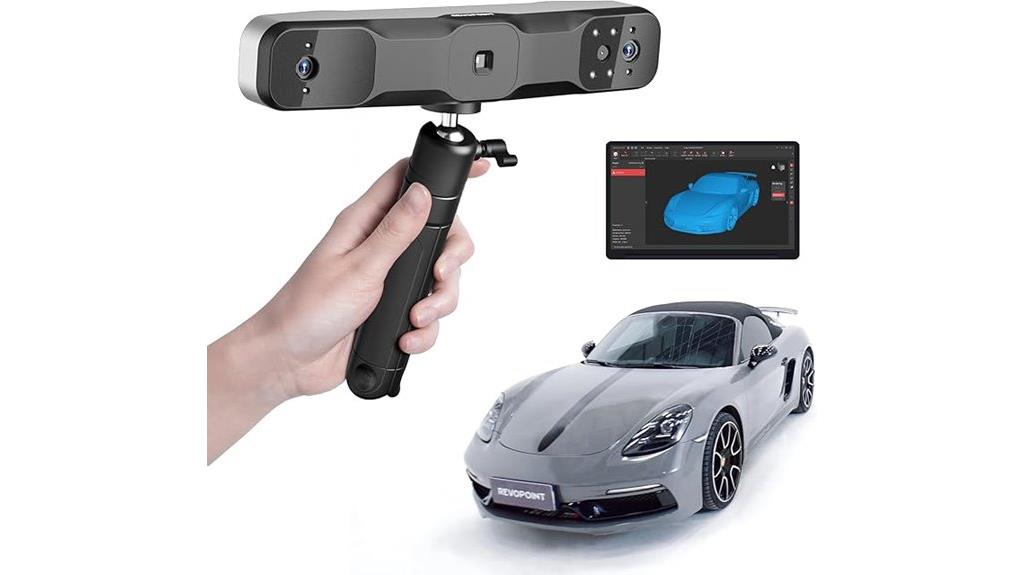
The Revopoint Range 2 stands out as an excellent choice for those seeking a versatile handheld 3D scanner that combines speed, accuracy, and color capture. Weighing just 8.9 ounces, it supports large object scans, full-color modeling, and body or face capture within seconds. Its high accuracy of 0.1 mm, combined with IMU stabilization and smart algorithms, ensures precise results. Compatible with Windows, macOS, Android, and iOS, it connects via Wi-Fi 6 or USB-C. The intuitive controls and free Revo Scan software make it user-friendly, perfect for 3D printing, art, or architecture projects, all at an affordable price point.
Best For: hobbyists, artists, and professionals seeking a portable, high-accuracy 3D scanner for large objects, full-color modeling, and body or face capture.
Pros:
- High accuracy of 0.1 mm with stable IMU and smart algorithms
- Supports multiple device platforms and outputs formats including STL, OBJ, PLY, and more
- Lightweight design (8.9 ounces) and easy-to-use software suitable for beginners and pros
Cons:
- May struggle with small, featureless, or reflective objects without target stickers
- Limited software compatibility to x86_64 architecture, restricting some system use
- Environmental factors like background interference can affect scan quality
Creality CR-Scan Ferret Pro 3D Scanner for 3D Printing
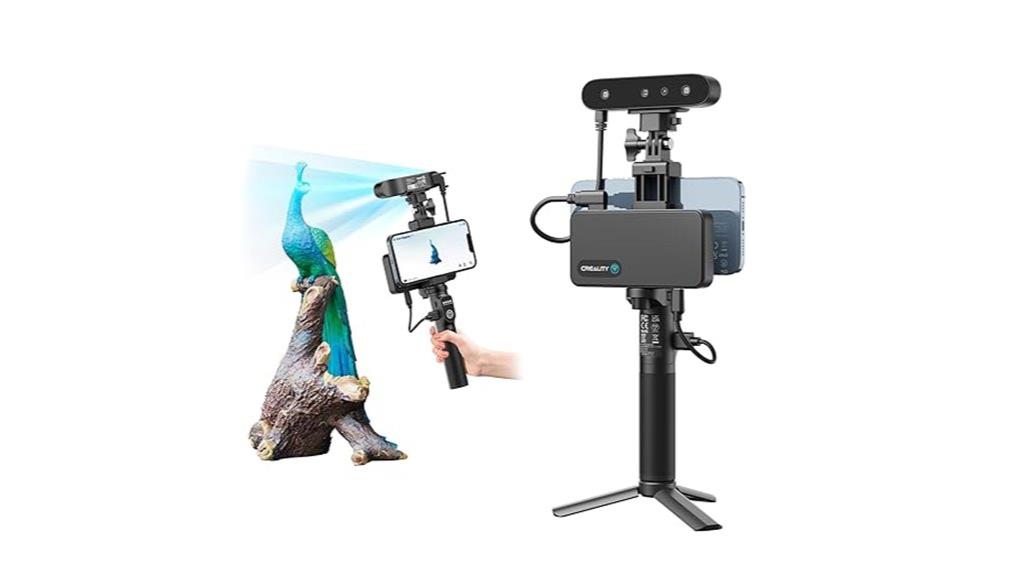
For professionals and serious hobbyists seeking high-precision, versatile scanning capabilities, the Creality CR-Scan Ferret Pro stands out as an excellent choice in 3D printing in 2025. It offers up to 0.1mm accuracy, a resolution of 0.16mm, and a fast 30FPS scanning speed, capturing detailed textures with a high-res color camera. Its dual laser modes—infrared and blue—allow for precise reverse engineering and high-detail scans. With flexible ranges from 150mm to 2000mm and support for outdoor use, it’s suited for various environments. The intuitive design, wireless connectivity, and accessories like the rotating turntable make it user-friendly for both professionals and enthusiasts.
Best For: professionals, serious hobbyists, and 3D printing enthusiasts seeking high-precision, versatile, and reliable 3D scanning solutions for both indoor and outdoor environments.
Pros:
- High accuracy up to 0.1mm with detailed texture capture via 2MP color camera
- Fast scanning speed of 30FPS and dual laser modes for versatile applications
- Wireless connectivity with WiFi6 and outdoor usability under sunlight (<30000 lux)
Cons:
- Software installation and instructions may be challenging and require patience
- Some users experience occasional tracking slips that can affect scan quality
- The 8-inch turntable may be limiting for larger objects, requiring manual handling
Factors to Consider When Choosing 3D Scanners for 3D Printing
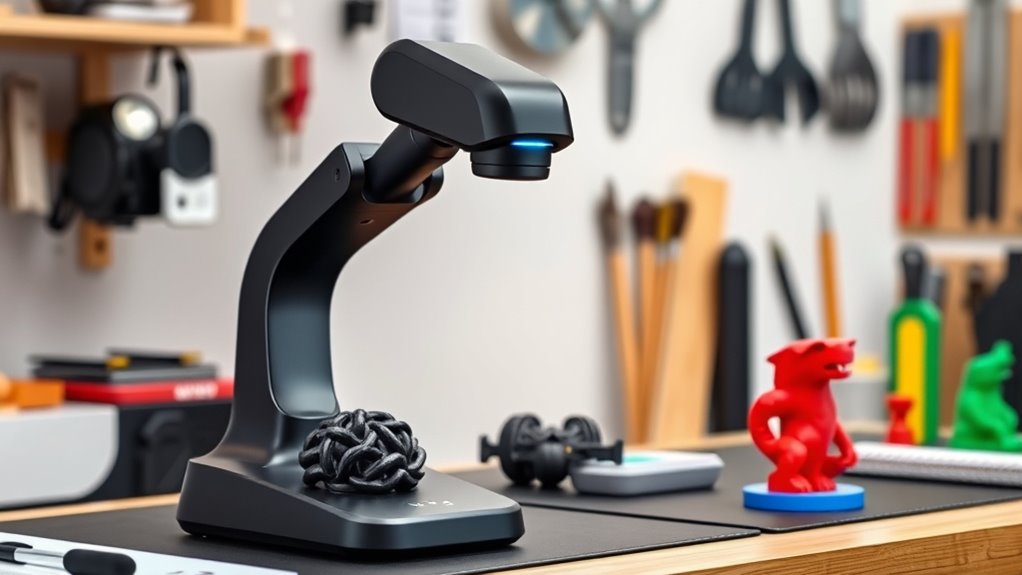
When selecting a 3D scanner for printing, I consider factors like accuracy, surface compatibility, and portability to match my project needs. The software and workflow also play a big role in ensuring smooth operation and integration. Plus, knowing how to prepare surfaces properly can make a big difference in getting high-quality scans.
Accuracy and Precision
Choosing a 3D scanner for printing isn’t just about speed or cost; accuracy and precision play a crucial role in guaranteeing your digital models are detailed and reliable. Higher accuracy, like 0.02 mm, produces more precise models, which is essential for high-quality prints. Precision, measured in microns, determines how well the scanner captures fine details and surface variations. Even small deviations can cause errors, impacting fit, function, and appearance of the final object. Achieving such accuracy often requires advanced laser or structured light technology and proper calibration. Keep in mind, higher accuracy might mean longer scan times and a need for a stable environment. Balancing these factors ensures you get reliable, detailed models for your 3D printing projects.
Surface Compatibility Needs
Selecting a 3D scanner that handles various surface types is essential for achieving accurate and reliable prints. Some surfaces, like metals, plastics, or textiles, can cause scanning errors due to their shininess, reflectivity, or darkness. To combat this, look for scanners with surface treatment options such as spray powders or markers, which improve data capture on challenging materials. Technologies like infrared, blue laser, or structured light often perform better with complex or reflective surfaces. Additionally, consider scanners that support scanning without surface preparation, saving time and effort. It’s important to verify that the scanner can adapt to different surface finishes and colors, ensuring consistent, high-quality results across a wide range of materials used in 3D printing.
Portability and Size
Portability and size are essential factors that influence how easily a 3D scanner fits into your workflow. Handheld models typically weigh less than 2 kg, making them simple to maneuver and carry around. Compact scanners are perfect for outdoor use or tight spaces, allowing quick setup and minimal transport hassle. Larger, desktop scanners usually need a stable workspace and a power connection, which limits mobility but provides higher accuracy and detail. Wireless connectivity options like WiFi or Bluetooth help reduce cable clutter and enable remote operation, boosting portability. Additionally, portable scanners with built-in batteries or power banks support on-the-go scanning without relying on external power sources. Choosing the right size and weight depends on your specific needs and where you’ll be using the scanner most.
Software and Workflow
When evaluating 3D scanners for your printing projects, the software and workflow capabilities often determine how smoothly you can turn raw scan data into high-quality models. A seamless process is crucial, involving effective point cloud processing, meshing, and post-editing tools. Compatibility with standard file formats like STL, OBJ, and PLY ensures easy integration with CAD programs and 3D printers. User-friendly interfaces, along with automated features such as auto-alignment and marker tracking, help reduce processing time and boost accuracy. Regular software updates are indispensable for maintaining compatibility with new hardware and fixing bugs. Additionally, efficient export options directly impact your productivity, especially when reverse engineering or editing models before printing. A well-designed software workflow makes all the difference in achieving precise, ready-to-print 3D models.
Surface Preparation Tips
Proper surface preparation is essential to achieving accurate 3D scans, especially when dealing with shiny, reflective, or dark-colored objects. I recommend cleaning surfaces thoroughly to remove dust, grease, and fingerprints, which can cause data gaps. Applying a scanning spray, like AESUB AZUL, creates a matte finish that improves laser or structured light reflection, boosting accuracy. For complex textures or dark hues, additional treatments such as matte sprays or markers help the scanner detect features more reliably. When working with highly reflective or transparent surfaces, specialized sprays or coating powders are necessary to prevent distortions and obtain detailed, precise scans. Taking these steps guarantees cleaner point clouds, minimizes post-processing, and results in more reliable 3D models for printing.
Frequently Asked Questions
Which 3D Scanner Offers the Fastest Scanning Speed?
The Faro Freestyle 3D Laser Scanner offers the fastest scanning speed I’ve come across. It captures detailed 3D data quickly, making it ideal for professionals who need rapid results. Its lightweight design and handheld operation allow me to scan large areas with ease. If speed is your priority, I recommend checking out this scanner because it combines quick performance with accuracy, saving you time on complex projects.
How Do 3D Scanners Handle Complex or Textured Surfaces?
Think of 3D scanners as detectives, piecing together clues from complex surfaces. They handle textured or intricate objects by using advanced laser or structured light technology, capturing every ridge and groove. High-resolution sensors and software algorithms fill in gaps, ensuring accurate models. So, when scanning complex surfaces, these scanners don’t miss a detail—they adapt, ensuring your 3D prints match the real thing perfectly.
What Is the Typical Learning Curve for Beginners?
I’d say the learning curve for beginners is moderate. At first, it might take some time to get comfortable with the scanner’s setup and software. However, most devices come with user-friendly interfaces and tutorials, which help a lot. With a bit of practice, I found that I could start capturing accurate scans fairly quickly. Patience and experimenting are key to mastering 3D scanning skills.
Are There Portable Options Suitable for On-Site Scanning?
Yes, there are portable options perfect for on-site scanning. I’ve used handheld scanners like the Artec Leo and EinScan Pro 2X, which are lightweight and easy to carry around. They let me capture detailed 3D models directly at the location, making the process convenient and efficient. These portable scanners are ideal if you need flexibility and quick results without sacrificing accuracy, especially for on-site projects.
How Do Maintenance and Calibration Impact Scanning Accuracy?
Maintenance and calibration are like tuning a vintage guitar — essential for top performance. When I keep my 3D scanner well-maintained and calibrated regularly, I see consistent accuracy and reliable scans. Skipping these steps introduces errors, making prints less precise. So, I make it a habit to follow the manufacturer’s guidelines, ensuring my scanner stays sharp, just like a well-tuned instrument, for the best 3D printing results.
Conclusion
Choosing the right 3D scanner can transform your printing projects, but the real game-changer is discovering which one aligns perfectly with your needs. Will the accuracy of the Revopoint MetroX or the versatility of the Creality CR-Scan Ferret Pro make all the difference? As technology advances, one thing’s certain—there’s more to these scanners than meets the eye. Are you ready to unleash the full potential of your 3D printing journey?
